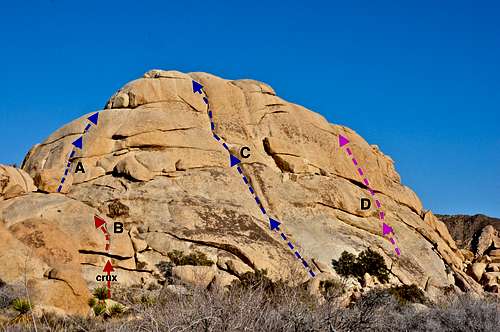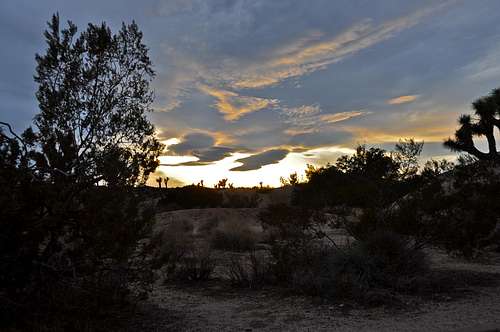-
 2670 Hits
2670 Hits
-
 82.48% Score
82.48% Score
-
 15 Votes
15 Votes
|
|
Route |
|---|---|
|
|
34.01788°N / 116.16446°W |
|
|
Trad Climbing |
|
|
Spring, Summer, Fall, Winter |
|
|
Half a day |
|
|
5.3 to 10d |
|
|
1 |
|
|
I |
|
|
Overview
Most visitors to Joshua Tree National Park's Hidden Valley campground notice the formation known as The Blob looking at its east face. The east face of The Blob is steep, well-featured and you wonder why this formation was named as such. If you, however, walk around to the west face of this formation, it becomes abundantly clear why this formation received the name The Blob. The west face looks like a molten blob that fell from the sky and pancaked against the ground.
The west face of The Blob resembles a dome with low-angle parameter that gradually becomes steep for only the last fifty to eighty feet of it culminating to a very big summit, if you can call it that.To reach the base of most of the upper routes, one needs to scramble up third and fourth class bottom part of the west face. There are, of course, a few routes such as Hobbit Roof, rated 10d, that start from the ground. Although there are a number of easier routes on this formation, the most intriguing route which is also one of the shortest draws the most attention. This route is known as Hobbit Roof. Originally rated at 10b, and now promoted to 10d difficulty rating, Hobbit Roof is a crack that splits a small roof in half. Climbing the roof, however, is not the crux of the route, but the thin face below it is. This very thin face is protected by only one bolt. Past the approach face, you can place solid protection in the crack and surmount the roof. The roof itself is rated 10a. The rest is much easier on low angle rock to the top.
Note: There are, of course, many more routes on the upper part of the west face of The Blob. These routes, however, were climbed in the old Joshua Tree tradition of minimal protection. You may see only two bolts protecting a sixty or eighty foot stretch of rock. For this reason, these poorly protected routes are omitted on this page.
Essential Equipment: One sixty meter rope, standard rack, slings, a few wide cams for some of the wide cracks.
Descend via southern slopes.
==========================================================
select routes of West Face of The Blob | |
| A | The Bong, 5.5, Standard Rack, extra pieces of wide cams |
| B | Hobbit Roof, 10d, 1 bolt, Standard Rack, cams up to 3 inches |
| C | Beginner's Two, 5.3, Standard Rack to include very thin to very wide., Long route |
| D | Beginner's One, 5.3, Standard Rack |
Getting There
From the western entrance to Joshua Tree National Park drive on Park Boulevard, formerly known as Quail Springs Road, for about nine miles to a major rock formation called “Intersection Rock.” Intersection Rock is a major landmark on the north side of Park Boulevard with ample parking for visitors and climbers alike. This rock, true to its name, sit at the cross roads to Hidden Valley Campground, Barker Dam Road and the road to Day use and picnic area.
Old Woman formation is located across from Intersection rock. The Blob is the next rock to the Old Woman which itself is the first formation to your left as you enter Hidden Valley Campground. Park here and walk back along the road for quarter of a mile until you see the west face of The Blob. From here, it's an easy walk to the base.



